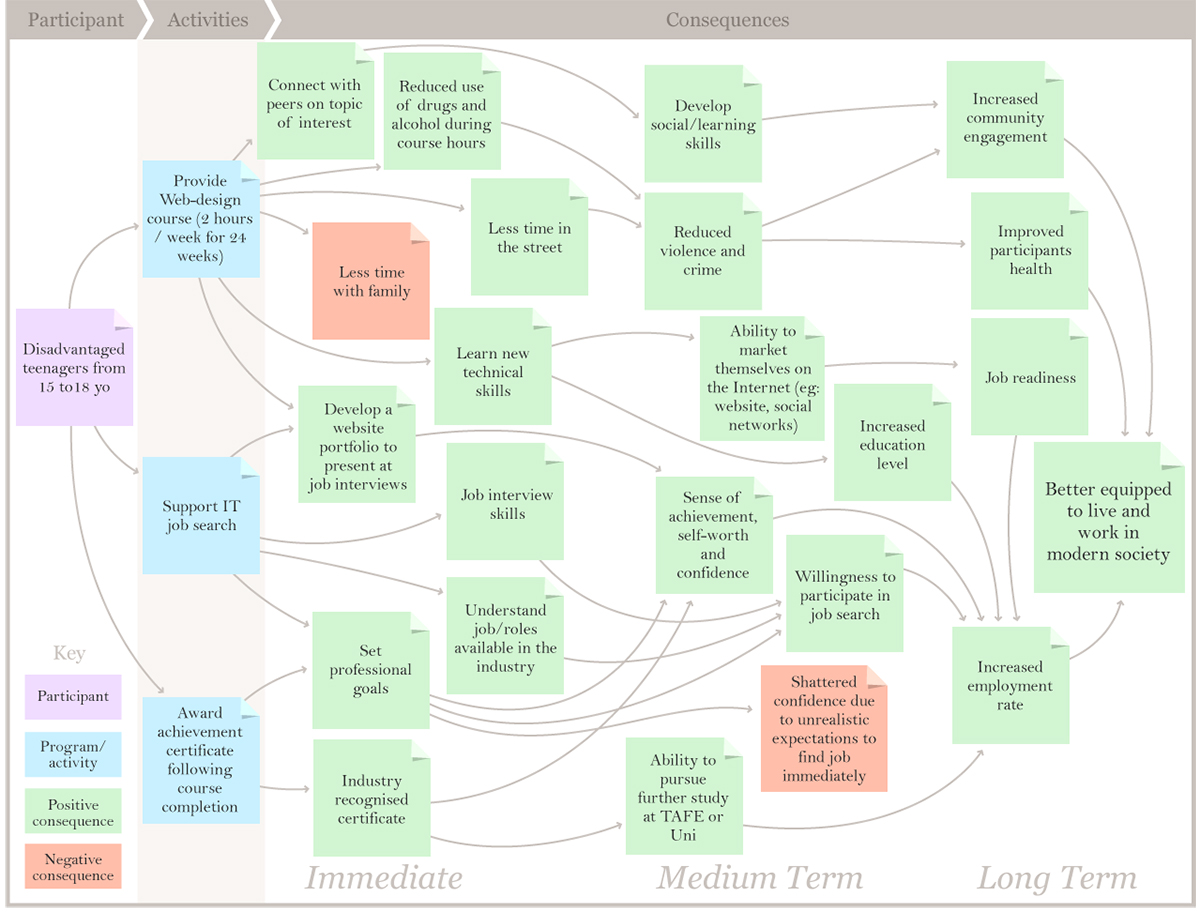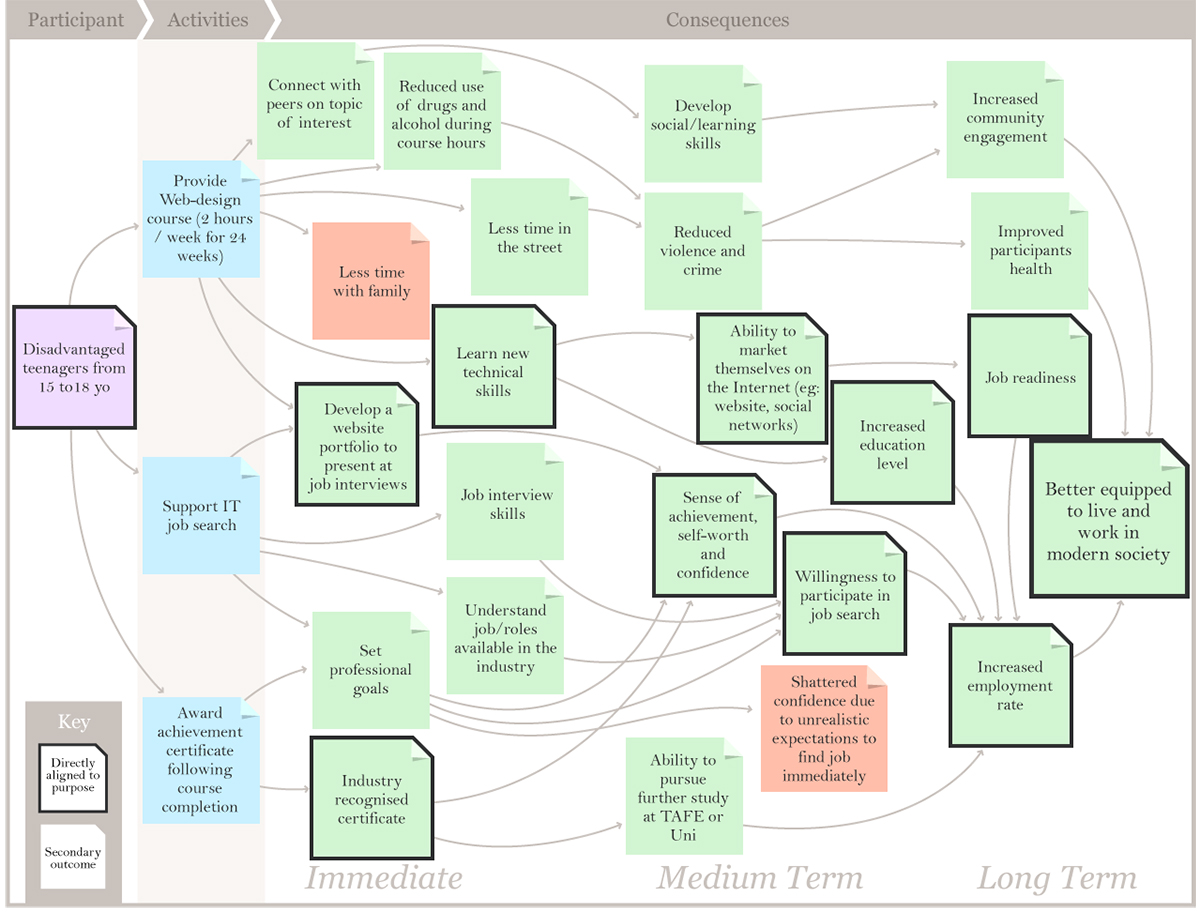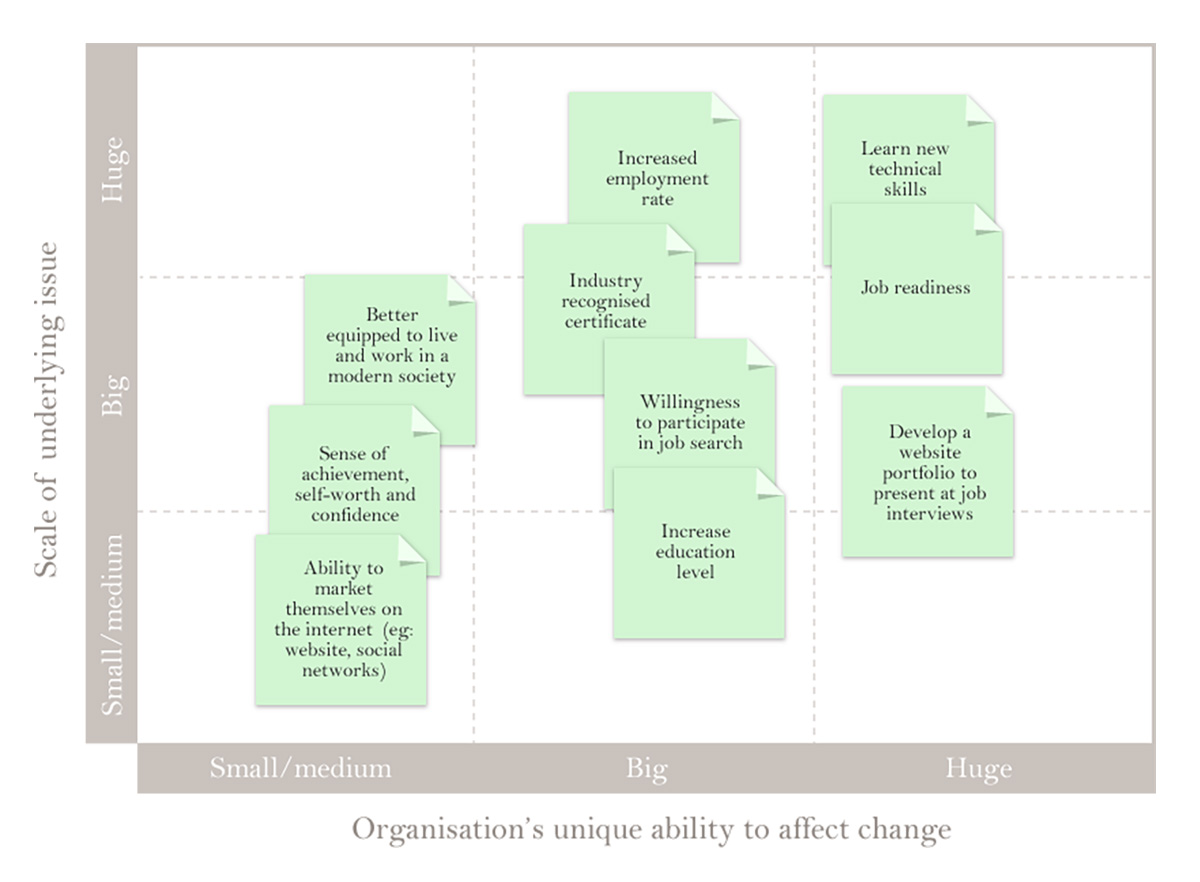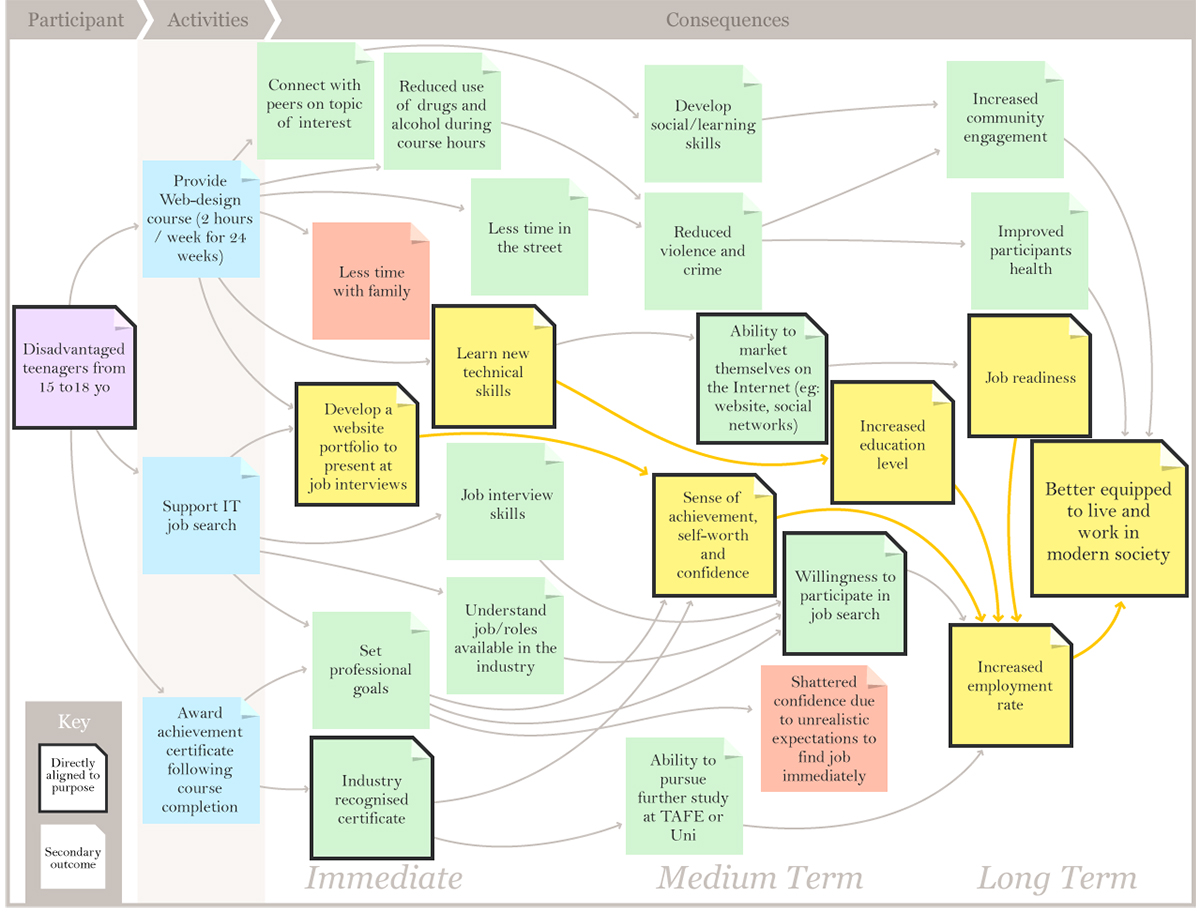
Finding the golden thread: a new approach to articulating program logic
The Golden Thread methodology is a visual and effective way to articulate program logic statements – the indispensable tools for describing how our activities lead to the impact we seek.

After falling through the rabbit hole and becoming quite lost, Alice, naturally enough, sought guidance.
“Would you tell me, please, which way I ought to go from here?”
“That depends a good deal on where you want to get to,” said the Cat.
“I don’t much care where–” said Alice.
“Then it doesn’t matter which way you go,” said the Cat.
“–so long as I get SOMEWHERE,” Alice added as an explanation.1
Involving ourselves in social change can leave us feeling rather like Alice. There are infinite needs, everything can seem rather complicated and finding out where we want to go can be difficult. We need a map showing where we are now, our intended destination, and a route we can follow to get us there.
Program logic
The program logic statement itself is the route for getting to our destination. To form the program logic statement, we start by identifying the key issues we want to address. We then describe our destination – the impact we wish to create. With our starting point and destination clarified, we can then mark out the route: we work with these participants, in these activities, using these inputs, which result in immediate, short-term, and long-term consequences, the aggregate of which – we hope – will result in the intended social impact.
What is a program logic statement? A program logic statement connects what you do, to the outcomes you seek. It articulates how the activities of a program lead to the consequences that will drive the final impact.
Easier said than done.
Articulating program logic statements is not straightforward. Many people confuse the ‘outputs’ of activities with ‘outcomes’, or are unsure of the sequence of events, or think that too many things are happening so that they cannot identify what to track or measure to determine whether they are being successful. Social missions are often high level, even nebulous. While ‘reducing disadvantage’ is laudable, this intention doesn’t tell us how to do it or how we will know that we have succeeded. Social programs operate in an open system, where many variables impact on clients, so isolating the impact of your program on clients can be difficult.
In its role as a funding manager, the Perpetual Foundation had become very aware of this difficulty.
As manager of over 540 charitable trusts and endowments, the Perpetual Foundation distributes more than $50 million each year in grants of various sizes, on behalf of its clients. After reviewing thousands of funding applications, it was concerned by the absence or low quality of responses to measurement and evaluation questions. To address this deficit, Perpetual and SVA Consulting designed a package comprising a two-day workshop, a follow-up half day and a supporting DVD to be delivered, without charge, to invited non-profit organisations who had applied for funding.
One hundred and forty participants from over 50 non-profit organisations attended the workshops that were held in five states in October and November 2010. The heart of the workshop was the Golden Thread methodology which assisted people to articulate their organisation’s program logic since it was the absence of program logic statements that impeded their ability to monitor and evaluate their programs. Ninety per cent of respondents reported that the Golden Thread methodology helped them clarify what to measure and how to evaluate. Almost all respondents reported using the output to inform strategy, make changes to their programs, and/or collect relevant outcome data.
To understand the Golden Thread method, we will look more closely at what program logic is, set out the methodology’s three steps which allows us to find the ‘golden thread’ within every social program, and then look at the process in action.
Program logic fundamentals
Described most simply, a program logic statement or theory of change (as it is sometimes called) is a statement of intended consequence. If we do these things, then we will achieve these things. If we provide services to older people in their homes, then we will prevent premature or unnecessary residential care. If we provide housing services to homeless people, then we will reduce homelessness.
There are numerous synonyms for such statements, but they all take the form: these sequences lead to these consequences. In the social sector, program logic statements are also described as ‘theory of social change’, and the word, ‘theory’ is apposite: it is a theory which we try to prove as valid by implementing it and then gathering evidence through measurement and evaluation.
Once formed, program logic statements form the base for developing strategy, planning, implementation, and measurement and evaluation. All up, a program logic statement provides the disciplined thinking required if programs are to achieve great results.
Finding the golden thread
We call the program logic statement the golden thread – that fine pathway of cause and effect within an organisation’s universe.
To find that thread, the first step in the Golden Thread method is to look at the big picture. In the second step, the core program logic (the golden thread) is identified. In the third and final step of the process, the program logic statement is written up, ready for approval and implementation.
Step one: develop a program map
A ‘program map’ is a precursor to a logic statement. In it the ‘universe’ that the program operates within is described. The program logic statement is then distilled from the program map.
The program map takes the following form:
Stakeholders take part > in a program (activity) > with consequences.
The starting point is identifying the stakeholders for the program. This universe is extensive and includes at least: the clients of the program; staff; funders; management; the community at large. This complex universe of stakeholders – each with a legitimate and often idiosyncratic interest in the program – is one of the things that makes the task of devising a program logic statement challenging.
That said, the common ground for all stakeholders is the intended benefits for the clients of the program. Thus, although the program map should have regard to the various interests of the range of stakeholders, the focus will generally be on the direct “client” of the program.
Consequences
The hard work begins when it comes to articulating consequences. There are three general principles to bear in mind.
The first is that consequences can be positive or negative, or both. For example, schools benefit most students, but there are always some students for whom the experience of school is negative. Being open to identifying both positive and negative consequences is crucial to ensuring the integrity of the resulting program logic statement.
The second general principle is that consequences don’t happen all at once. Consequences can be immediate, short term, and longer term. The immediate consequences may be termed the ‘outputs’ or ‘direct deliverables’ of the program; these are generally what workers are directly involved in securing. The short and longer-term consequences can be termed ‘outcomes’.
The third general principle is to be exhaustive. It is important to identify as many consequences that arise from the program as possible including those which are indirect or seemingly tangential. This is because the program logic is distilled from this ‘universe’ of consequences, so taking a comprehensive approach is most likely to yield a sound logic statement that does not overlook anything.
With these three principles in mind, we suggest taking the following steps:
- Write down all the positive consequences of the program (or activity), onto green post-it notes.
- Write down all the negative consequences of the program on red post-it notes.
- Arrange the post-it notes on a board, categorised as immediate consequences (outputs), and short term and long term consequences (outcomes).
- Finally, try to draw links between consequences: indicating when one consequence leads to another.
Youth Transition to Work program
To illustrate the Golden Thread method, we will look at a program that assists disadvantaged teenagers, aged 15-18 years of age to gain access to the workforce. To this end, the young people:
- engage in a web-design course (2 hours per week, for 24 weeks)
- are awarded an achievement certificate on course completion
- are then supported to find a job in information technology.
This movement through a program is common though there are services, such as respite care or meals on wheels, that don’t involve progressing out of the program but rather are provided for life.
The consequences that were identified were:

The program map is now complete, and we are ready to proceed to the next step.
Step two: prioritising
As it stands, the program map is too complex to explain, let alone evaluate. This complexity can give rise to organisations not persisting with logic statements or, if they do not refine the program map further, ending up with poor statements.
The way through the complexity is to prioritise the consequences, to identify the outcomes that are considered to be most instrumental in achieving the overall mission. It is the prioritised program map that underpins the program logic statement.
In order to prioritise the consequences, criteria are required. There are several which can be used, including:
- How fast the consequences are achieved
- Whether others are tackling the underlying problem or issue
- The size of the underlying problem or issue
- The potential for systematic change to result from the actions of the organisation
- Availability and sustainability of funding for the underlying problem or issue.
Others can be identified. However, the Golden Thread method specifically recommends the use of two criteria.
The first criterion is the organisation’s overall purpose, whether described as mission, vision, guiding principles, or values. This is the statement that describes the world as we wish it to be and is the future towards which the organisation is working. The statement is necessarily high level and is not time-limited, though it should be specific enough to guide decision-making.
In our example, the overall mission statement is: ‘Disadvantaged young people are equipped to live and work in modern society’. By considering the range of consequences identified in the program map in terms of the ‘purpose filter’, items are accorded relative priority. Outcomes such as job readiness and increased employment clearly rate highly. On the other hand, consequences such as community engagement and improved health, while important in themselves, are of a secondary significance, when considered in terms of the organisation’s purpose.

The second criterion is two-dimensional, and is used to further prioritise the consequences selected after considering the purpose criteria. The dimensions are:
- The scale or significance of the underlying issue This relates to the scale of the underlying problem or issue addressed by each consequence (specifically in the community in which the program is working, and amongst its stakeholders/participants/clients).
- The unique ability of the organisation to affect change This involves judging whether the program is critical in affecting the consequence, and addressing the underlying issue – that is: firstly, that the organisation has the funding, skills, location, standing in the community, and reputation with the target group required to conduct the program, and, secondly, judging whether any other organisation would address this issue if the program did not exist. If the assessment is that the organisation can address the issue well and that no-one else will, then the organisation has a unique ability to affect change.
As with any two dimensions, these can be used to form a matrix, using scales such as small/medium, big, huge (note that few participants will rank an issue as of less than “big” importance: the objective is to identify relativity!) For more on using matrices in decision making, see A framework for making difficult decisions.
The Golden Thread prioritisation matrix for the example program is as follows:

Note that the significance of ‘Ability of participants to market themselves on the Net’ was judged to be low on both dimensions. On the other hand, ‘Learning new technical skills’ was judged to be highly significant on both dimensions. That is, it was judged as a critical variable in terms of young people being able to secure employment, specifically within the IT sector, and also something that would not be addressed without the program.
In terms of the method, those consequences which are given priority using the two criteria should now be rewritten onto yellow post-it notes and placed on the program map. The next step is to ‘work backwards’, from the prioritised consequences to the activities. In this way, the logical connections are made, and the core program logic emerges from the program map. This is what SVA Consulting did in a number of workshops and it was while doing this that one participant said, ‘There’s the golden thread!’ which is how the name for this methodology was born.

We are now ready to write up the program logic statement.
Step three: preparing the program logic statement
With the work of finding the thread in the map done, the final step is to craft a statement which captures the lessons and decisions made through the Golden Thread process.
Stated in full, a program logic statement takes the following form:
- The key issue/s the program addresses
- The participants who take part/the target group
- The activities in which they participate
- The immediate consequences (the ‘outputs’)
- The short term consequences
- The long term consequences
- Impact on the issue the program is addressing.
In our example this format would be:
The key issue the program addresses is people who are excluded from the mainstream workforce. The program is specifically directed to disadvantaged young people, aged 15-18, who are, or are likely to be, excluded from the workforce.
The participants undertake a course in web design, conducted over 24 weeks, for two hours each week. Thereafter, they are given support to find suitable employment opportunities in the IT sector.
The principle immediate consequences are two-fold:
- the participants learn new technical skills
- the participants develop a website portfolio to present at job interviews.
The short term consequences for the participants are:
- a sense of achievement, self-worth and confidence
- an ability to pursue further study at TAFE or Uni
- willingness to participate in job search.
The longer term consequences are:
- participants are job ready
- participants gain employment
- participants are better equipped to live and work in modern society.
In this way, the program contributes to reducing the number of people who are marginal to or excluded from the mainstream workforce.

The methodology helped to put into perspective those activities which are important, rather than perceived as important.”
As a result of the Golden Thread method, a number of activities were de-emphasised. For example, the completion certificate that was previously seen as important was now recognised as being comparatively insignificant. Similarly, the ability of participants to market themselves on the Internet – an idea that seems crucial at first glance – was now understood to be of limited value.
As one of the workshop participants reported, “The methodology helped to put into perspective those activities which are important, rather than perceived as important”.
The Golden Thread method can be followed by one person, though our experience is that involving a group of people, preferably from the range of stakeholder groups – clients, workers, managers, board members, funders – is most likely to yield the best analysis. Using an independent facilitator, especially someone who has experience in the method, will help to ensure that the process stays on track and that everyone is heard. In general, we recommend a one-day workshop for each program supported by processes for documenting and reviewing the workshop output.
The golden thread in action
As noted, program logic statements form the basis for developing strategy, program design, planning, implementation, and measurement and evaluation.
One organisation with whom we worked addresses the complex needs of women and children in domestic violence situations. However, it lacked clarity on what to focus on, and did not know how to evaluate outcomes. This impacted directly on its ability to tell its ‘story’ to funders and it also resulted in poor planning and unfocused implementation.
By using the Golden Thread methodology, the organisation’s management was able to gain clarity around what it did and why it mattered, which led it to focus on four core activities. “(We) significantly reduced a program we were running, since it was not achieving the outcomes we were seeking.” By developing program logic statements, it was also able to establish what data it needed to collect, enabling it to develop a powerful and evidenced case for its program. It also intends to use this data to guide its future planning. The CEO commented, “It provided the executive with a framework for developing performance metrics, and informed our strategic planning process”.

The Golden Thread methodology helped us to clarify what outcomes were more important and as a result what data we should be collecting to demonstrate and improve our impact.”
Start-up social enterprise, No Sweat Fashions provides education and employment opportunities for newly arrived refugees and other migrants who face social isolation. The organisation used the Golden Thread methodology to engage its stakeholders in understanding what outcomes and therefore what activities it should prioritise to achieve the impact it wanted. The methodology helped the organisation to understand which activities linked to the most important outcomes, as well as what it should measure on an ongoing basis to demonstrate those outcomes. It also provided a platform for discussion with all its various stakeholders (community service organisations, board members) about the best way to engage with its primary beneficiaries (refugees or disadvantaged migrant women). As the CEO said, “The Golden Thread methodology helped us to clarify what outcomes were more important and as a result what data we should be collecting to demonstrate and improve our impact.”
Conclusion
To avoid Alice’s experience of getting lost, and having to rely on the advice of the Cat, a map and a route is needed. A program logic statement guides social programs towards their intended social impact. The better the statement, the greater the ability to implement the program to best effect.

A bonus from the Golden Thread process was that everyone now understood the program in the same way.”
The Golden Thread methodology is one way of developing a program logic statement. The process involves developing a program map that describes the ‘universe’ in which a program operates, and identifying the core program logic – the golden thread – within that map. This thorough process takes into account the complexity that is invariably associated with social purpose activities.
We have found this tool very useful, especially for processes that involve a number of people. Being highly visual – using coloured post-it notes on a board in view of all the participants – the process helps to ensure that everyone has similar levels of understanding and encourages everyone to contribute. As one workshop participant said, “A bonus from the Golden Thread process was that everyone now understood the program in the same way. Ask any team member about the program, and you get the same answer. This is not what used to happen!”
Once formed, the program logic statement provides the common ground for several other key functions including planning, measurement and evaluation and, most importantly, implementation. Expressed in the negative: without a clear, concise and comprehensive program logic statement, in all likelihood, an organisation will have only a poor understanding of what it is seeking to achieve, and will have a significantly impaired ability to plan, monitor and evaluate what it is doing. For these reasons, every program is enhanced by a program logic statement and the Golden Thread method is a powerful tool for developing these statements.
Authors: Duncan Peppercorn and David James





